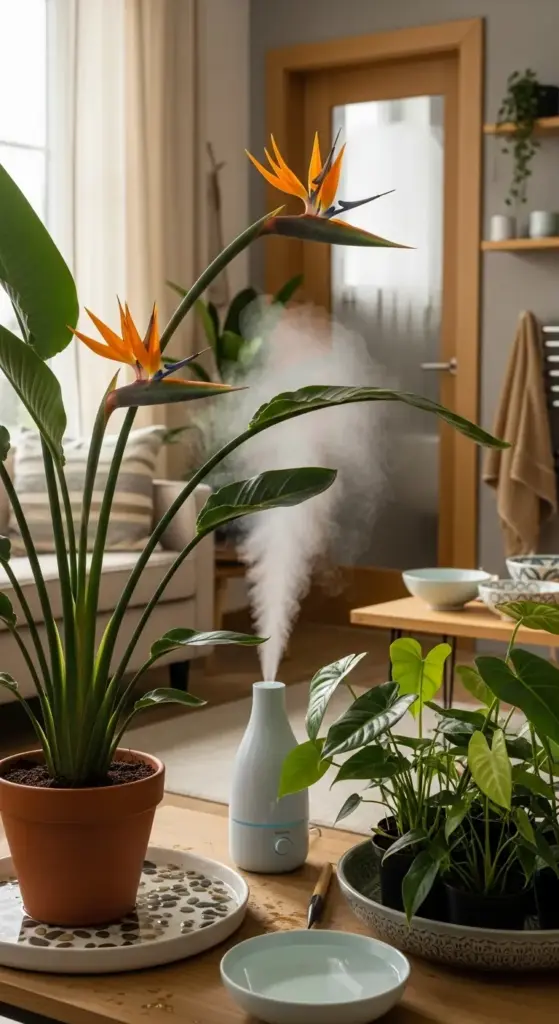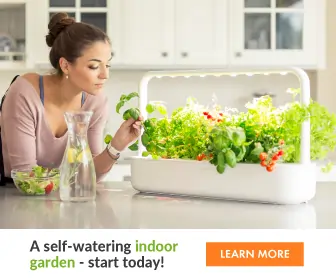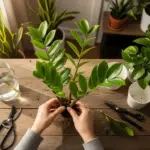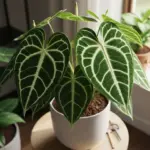4. Optimize Humidity and Temperature in Your Home Environment

My Bird of Paradise looked like it was dying a slow death until I realized my apartment’s dry winter air was basically torturing it. Crispy leaf edges and stunted growth were my wake-up calls.
These tropical plants need 40-60% humidity to thrive, but most homes sit around 20-30% during heating season. No wonder my poor plant was struggling!
Simple Humidity Hacks That Actually Work
Pebble trays are my go-to humidity boosters. Fill a shallow tray with stones, add water until it’s just below the stone tops, then set your pot on top.
The key is keeping the pot above water level – you want evaporation, not soggy roots.
I group my tropical plants together to create a humidity microclimate. Plants naturally release moisture through their leaves, so clustering helps everyone.
Misting is overrated and can actually cause fungal problems. I learned this after getting brown spots on my leaves from too much enthusiastic spraying.
Household Items That Create Perfect Growing Conditions
A humidifier changed everything for my plant collection. I run a cool-mist one near my plants during winter months.
Can’t afford a humidifier? Bowls of water placed around your plant area work surprisingly well. I use decorative bowls so they don’t look weird.
Wet towels draped over radiators add tons of moisture to the air. Just make sure they’re clean towels – nobody wants musty smells.
Pro tip: Your bathroom probably has perfect humidity after showers. I move struggling plants there temporarily during dry spells.
Temperature Control for Different Heating Systems
Forced air heating is brutal on plants. Those vents blast hot, dry air that can damage leaves in hours.
Radiator heat is gentler but still dries out the air. I keep water containers on top of mine during winter.
Baseboard heating creates more even temperatures, but watch for hot spots near the units. I learned this when my plant’s lower leaves got crispy.
Space heaters can create dangerous temperature swings. If you use them, keep plants at least 6 feet away from direct heat.
Protecting Plants from HVAC Systems
Never place plants directly under air vents. I made this mistake in my first apartment – the constant air flow stressed my plant terribly.
AC vents blow cold, dry air that can shock tropical plants. I use vent deflectors to redirect airflow away from my green babies.
Heating vents are even worse because hot air rises and creates convection currents that dry out leaves fast.
Simple solution: Move plants 3-4 feet away from any direct airflow. They’ll still get ambient temperature control without the stress.
Creating Microclimates in Small Spaces
I turned my bathroom into a plant spa during winter. The shower steam creates perfect tropical conditions naturally.
Kitchen humidity from cooking helps too. My Bird of Paradise sits near the sink where it gets gentle moisture from daily dishwashing.
Bedroom corners away from heating vents often have the most stable temperatures and humidity levels.
Group plants by similar needs. My tropical corner has a small humidifier, pebble trays, and plants clustered together for maximum effect.
Temperature Sweet Spots and Warning Signs
65-80°F is the ideal range for Bird of Paradise plants. They can handle brief dips to 60°F but hate anything below that.
Sudden temperature drops cause leaves to curl and brown. I learned this during a cold snap when my heat went out overnight.
Hot spots near windows can cook plants during summer. I use sheer curtains to diffuse intense afternoon sun.
Watch for stress signals: curling leaves usually mean too hot or dry, while yellowing can indicate temperature shock.
Budget-Friendly Climate Control Solutions
DIY humidity trays cost under $10 to make. Large plant saucers, aquarium gravel, and water – that’s it.
Shower curtains can create temporary humidity tents around plants. Sounds weird, but it works during extreme dry spells.
Strategic plant placement costs nothing but makes huge differences. I map out temperature zones in my apartment seasonally.
Free humidity boost: Leave bathroom doors open after showers to share that tropical moisture with nearby plants.
Think you’ve mastered the environment? There’s one final piece that separates thriving plants from surviving ones. The next section reveals my fertilizing secrets that turned my slow-growing Bird of Paradise into a leaf-producing machine – including the common feeding mistake that actually stunts growth. Click below to unlock the nutrition game-changer!









GIPHY App Key not set. Please check settings